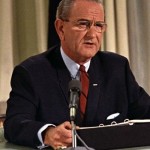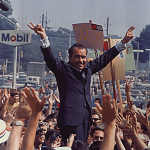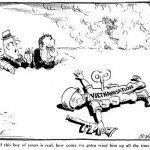
In 1969 the Vietnam War was transformed by the arrival of a new president with a new position. In November 1968 the United States presidential election was won by Richard Nixon, a Republican senator from California who had served as vice president under Eisenhower (1953-61) and contested the presidency against John F. Kennedy (1960). When Nixon took office in January 1969 the Vietnam War was unpopular with a majority of Americans. In the previous year (1968) it had cost 14,600 American lives and $US30 billion. Unlike Johnson in 1965, Nixon was a realist who did not believe the Vietnam War was winnable. Instead, he looked for a way to wind back American involvement in Vietnam, while maintaining South Vietnam and avoiding international humiliation. The policy Nixon developed was called Vietnamisation. It aimed to build up, develop and strengthen the South Vietnamese military so that it could assume combat roles from the Americans. As Vietnamisation proceeded, US troops could be gradually withdrawn from Vietnam.
Nixon’s attempt to ‘Vietnamise’ the war followed a time when many American commanders wanted more US troops in Vietnam, not less. In mid-1968, in the wake of the Tet Offensive, the number of US combat troops in Vietnam peaked at more than 580,000 men. Generals like William C. Westmoreland wanted a minimum of 700,000 soldiers, a number Westmoreland claimed would bring victory inside three years. With American forces already stretched, an escalation of this size would require expanding the draft and mobilising reservists. Westmoreland also wanted an extension of American ground operations to Laos and Cambodia, where communists were taking refuge and obtaining supplies. Even more controversially, Westmoreland sought authorisation for the use of tactical nuclear weapons “to tell Hanoi something”. The White House, however, had lost confidence in Westmoreland’s assessments after the heavy losses of Tet. In June 1968 Westmoreland was recalled to Washington and replaced as MACV commander by Creighton Abrams.

The failures in Vietnam had taken their toll on Lyndon Johnson. The president was fatigued, concerned about his health and distraught about the 4,200 Americans killed during the Tet Offensive. The American anti-war movement was growing in size and prominence and Johnson’s personal popularity was on a downward slide. The Vietnam War had split Johnson’s Democratic Party into four hostile factions. To compound these problems, 1968 was an election year. Two popular Democratic candidates – the anti-war Eugene McCarthy and Robert F. Kennedy, the popular younger brother of the assassinated president – announced their intention to run for the presidency. For the first time in 80 years, the incumbent president was in serious danger of losing his party’s nomination for the presidency. On March 31st 1968 Johnson shocked the world by calling a halt to US air strikes on North Vietnam. He appeared on public television and said that he would not seek re-election for a second term as president.

The November 1968 presidential election was eventually won by Republican candidate Richard Milhous Nixon. Nixon had previously served two terms as vice-president under Dwight Eisenhower (1953-61). He ran for president against John F. Kennedy in 1960 but was narrowly defeated. Nixon’s public image was that of an anti-communist ‘hawk’, a leader willing to take tough action against Hanoi and its allies. Just weeks after taking office, Nixon authorised Operation Menu, the massive aerial bombardment of suspected communist positions in Laos and Cambodia. This operation continued until May 1970. Though figures vary, evidence suggests more than two million tons of bombs were dropped by American planes outside the borders of Vietnam. Operation Menu was kept secret from the media, the American public and even the US Congress, chiefly to avoid agitating the anti-war movement.
Nixon immediately found himself under considerable pressure to find a workable resolution within Vietnam. A poll in early 1969 suggested that 56 percent of Americans believed their nation’s involvement in Vietnam was a mistake. At a July 1969 press conference in Guam, Nixon outlined his broad policy position on south-east Asia. It was to become known as the Nixon Doctrine:
“The nations of Asia can and must increasingly shoulder the responsibility for achieving peace and progress in the area with whatever cooperation we can provide. Asian countries must seek their own destiny, for if domination by the aggressor can destroy the freedom of a nation, too much dependence on a protector can eventually erode its dignity. But it is not just a matter of dignity, for dependence on foreign aid destroys the incentive to mobilise domestic resources – human, financial, material. In the absence of this, no government is capable of dealing effectively with its problems and adversaries.”
“The multi-faced scheme did not work. Although US ships, planes, rifles, helicopters poured in, South Vietnam became dependent on US aid to keep its army in the field. Aid sustained the corrupt regime of General Nguyen Van Thieu, a government of self-serving officials, unpopular and ultimately incapable of conducting a winning effort. As the ranks of the ARVN swelled to more than one million, some Vietnamese groups complained that ‘Vietnamisation is only the change in the colour of the dead’. ‘We’re no longer here to win’, said one US military officer, ‘We’re merely campaigning to keep the [American] casualties down’.”
Thomas Paterson, historian
What Nixon was suggesting was a reiteration of John F. Kennedy’s position in 1963: the South Vietnamese must take responsibility for their own defence. Since 1965 the South Vietnamese army (ARVN) had performed a secondary role in combat operations against the Viet Cong. The Nixon Doctrine argued that they should take command of their own war. To facilitate this, Washington would provide training and equipment for an expanded ARVN, as well as territorial forces and police units. The territorial forces – essentially civilian militias formed by recruiting villagers – would be responsible for maintaining security in rural areas, while regular ARVN troops would seek out and engage the Viet Cong. The South Vietnamese army was increased in size from 427,000 (late 1968) to 516,000 (1971). The territorial forces expanded from 393,000 to 532,000 in the same period. The safety and sovereignty of South Vietnam would stand or fall on the ability of its own troops to fight. The ‘Vietnamisation’ of the war would allow a gradual withdrawal of US troops. The first significant departure of American soldiers occurred on July 7th 1969.

By the start of 1970, the South Vietnamese military had more than one million men in uniform. These forces were equipped with $US4 billion worth of American equipment: rifles, artillery, munitions, helicopters and more. Most ARVN officers were given training in command, military strategy and counter-insurgency warfare. This made South Vietnam one of the most militarised nations in Asia. The ARVN should, in theory, be capable of withstanding aggression from the North. The reality was starkly different. Improving the size of the ARVN was much easier than improving its effectiveness. Like its young government, the South Vietnamese military was undermined and weakened by division, corruption and incompetence. A critical problem was poor leadership. South Vietnamese officers lacked initiative and were incapable of commanding respect from their men. Many were also lazy and combat-shy, unwilling to take risks or lead their teams into dangerous areas.
Along with these military weaknesses, the economy of South Vietnam had now become reliant on American aid. The North, in contrast, was receiving greater amounts of aid from the Soviet Union. At the end of March 1972 some 54,000 North Vietnamese Army (NVA) troops invaded South Vietnam, equipped with new Soviet tanks and weaponry. Their objective was to conquer two-thirds of Vietnam by the end of the year. This invasion, however, proved a disaster. It was poorly planned and given objectives that were unachievable with the number of available troops. Inexperienced NVA officers were unable to execute battle plans, exposing their lack of experience in conventional warfare. The ARVN, armed with US-supplied heavy artillery and aircraft, imposed heavy losses on the NVA. By the end of 1972 the two armies had encountered a Korea-like stalemate. The NVA occupied barely one-quarter of South Vietnam, while the ARVN lacked the numbers to expel them.

1. Vietnamisation was a policy devised by US president Richard Nixon, who won office in November 1968. In this year the Vietnam conflict had cost 14,600 US lives and $US30 billion.
2. Vietnamisation aimed to strengthen the South Vietnamese army (ARVN) so it could assume combat operations against the Viet Cong. This would allow for a gradual withdrawal of US troops.
3. Nixon’s intention to slowly withdraw was at odds with the wishes of some US commanders. The Tet Offensive suggested that American involvement in Vietnam should be escalated, they believed.
4. Unveiled in 1969, Vietnamisation produced significant increases in the ARVN, which grew from 427,000 in late 1968 to 516,000 in 1971. South Vietnam’s territorial and police forces grew similarly.
5. By 1970 South Vietnam had more than one million men in uniform and the ARVN was being supplied with US weapons, munitions, artillery and vehicles – but the ARVN was still beset by poor leadership, low morale, corruption and incompetence.
© Alpha History 2016. Content on this page may not be republished or distributed without permission. For more information please refer to our Terms of Use.
This page was written by Jennifer Llewellyn, Jim Southey and Steve Thompson. To reference this page, use the following citation:
J. Llewellyn et al, “Vietnamisation”, Alpha History, accessed [today’s date], https://alphahistory.com/vietnamwar/vietnamisation/.
